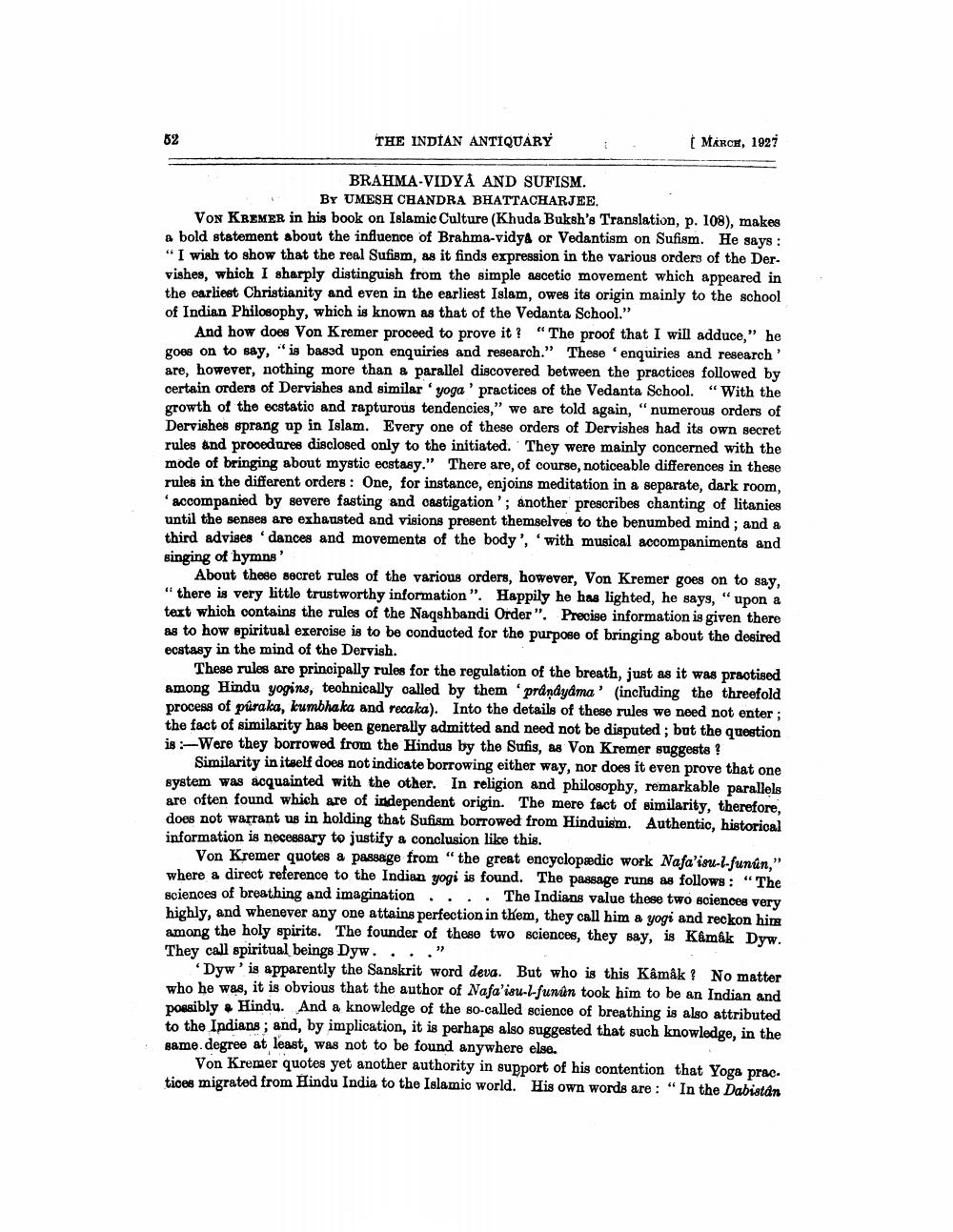________________
THE INDIAN ANTIQUARY
MÁRCH, 1921
BRAHMA-VIDYÅ AND SUFISM.
BY UMESH CHANDRA BHATTACHARJEE. VON KREMER in his book on Islamic Culture (Khuda Buksh's Translation, p. 108), makes a bold statement about the influence of Brahma-vidya or Vedantism on Sufism. He says: "I wish to show that the real Sufism, as it finds expression in the various orders of the Der. vishes, which I sharply distinguish from the simple ascetic movement which appeared in the earliest Christianity and even in the earliest Islam, owes its origin mainly to the school of Indian Philosophy, which is known as that of the Vedanta School."
And how does Von Kremer proceed to prove it? "The proof that I will adduce," he goes on to say, "is based upon enquiries and research." These 'enquiries and research are, however, nothing more than a parallel discovered between the practices followed by certain orders of Dervishes and similar yoga ' practices of the Vedanta School. “With the growth of the ecstatic and rapturous tendencies," we are told again, "numerous orders of Dervishes sprang up in Islam. Every one of these orders of Dervishes had its own secret rules and procedures disclosed only to the initiated. They were mainly concerned with the mode of bringing about mystic ecstasy." There are, of course, noticeable differences in these rules in the different orders: One, for instance, enjoins meditation in a separate, dark room, 'accompanied by severe fasting and castigation'; another prescribes chanting of litanies until the senses are exhausted and visions present themselves to the benumbed mind; and a third advises 'dances and movements of the body', 'with musical accompaniments and singing of hymns'
About these secret rules of the various orders, however, Von Kremer goes on to say, " there is very little trustworthy information". Happily he has lighted, he says, "upon a text which contains the rules of the Naqshbandi Order". Precise information is given there as to how spiritual exercise is to be conducted for the purpose of bringing about the desired ecstasy in the mind of the Dervish.
These rules are principally rules for the regulation of the breath, just as it was practised among Hindu yogins, technically called by them 'prandydma' (including the threefold process of püraka, kumbhaka and recaka). Into the details of these rules we need not enter ; the fact of similarity has been generally admitted and need not be disputed; but the question is :-Were they borrowed from the Hindus by the Sufis, as Von Kremer suggests !
Similarity in itself does not indicate borrowing either way, nor does it even prove that one system was acquainted with the other. In religion and philosophy, remarkable parallels are often found which are of independent origin. The mere fact of similarity, therefore, does not warrant us in holding that Sufism borrowed from Hinduism. Authentic, historical information is necessary to justify a conclusion like this.
Von Kremer quotes a passage from "the great encyclopædic work Nafa'isu-l-funun," where a direct reference to the Indian yogi is found. The passage runs as follows: "The sciences of breathing and imagination... The Indians value these two sciences very highly, and whenever any one attains perfection in them, they call him a yogi and reckon hins among the holy spirite. The founder of these two sciences, they say, is Kamak Dyw. They call spiritual beings Dyw. ..."
Dyw' is apparently the Sanskrit word deva. But who is this Kåmåk! No matter who he was, it is obvious that the author of Nafa'isu-l-funun took him to be an Indian and possibly . Hindu. And a knowledge of the so-called science of breathing is also attributed to the Indians; and, by implication, it is perhaps also suggested that such knowledge, in the game. degree at least, was not to be found anywhere else.
Von Kremer quotes yet another authority in support of his contention that Yoga prac. ticos migrated from Hindu India to the Islamic world. His own words are : "In the Dabistan




